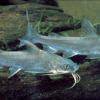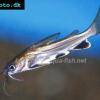Jordans catfish - Arius seemani
Scientific name: Arius seemani
Common name: Jordans catfish
Family: Ariidae
Usual size in fish tanks: 30 - 35 cm (11.81 - 13.78 inch)
014
Recommended pH range: 6.8 - 8
Recommended water hardness: 12 - 18°N (214.29 - 321.43ppm)
0°C 32°F30°C 86°F
Recommended temperature range: 24 - 27 °C (75.2 - 80.6°F)
The way how these fish reproduce: Spawning
Where the species comes from: Central America
Temperament to its own species: aggressive/territorial
Temperament toward other fish species: aggressive/territorial
Usual place in the tank: Middle levels
Natural Habitat and Origin
The Arius seemani, commonly known as Jordan’s Catfish, is native to the Pacific coastline, ranging from Mexico through Central America and down to the northern parts of South America. It inhabits estuaries and brackish coastal waters, where it thrives in slightly salty conditions. In its juvenile stage, it can also be found in freshwater rivers and streams before migrating to saltier waters as it matures.
Diet and Feeding
Jordan’s Catfish is an omnivore, meaning it will eat both plant and animal matter. It has a strong preference for live foods such as small fish, shrimp, and insects. However, it readily accepts a variety of alternatives including frozen seafood, sinking pellets, and dried food with high protein content. To maintain a balanced diet, offering a mix of both plant-based and meaty foods is recommended, ensuring all nutritional needs are met for this active species.
Sex Differentiation (Sexing)
Determining the sex of Arius seemani is a challenging task and is typically not recommended for the casual aquarist. Unlike some fish species, there are no obvious external differences between males and females. The only reliable method is through internal examination, which can stress or harm the fish, so it is generally avoided unless done by an expert.
Reproduction and Breeding
In captivity, breeding of Jordan’s Catfish is quite rare. In the wild, the breeding process is fascinating: the female lays around 100 large eggs, each about the size of a marble. The male then carefully guards the eggs in his mouth (mouthbrooding) to protect them until they hatch, a process that takes several weeks. Due to the specific water conditions required and the large size of the fish, breeding efforts are mostly limited to their natural habitat.
Lifespan and Care
With proper care, the Jordan’s Catfish can live for over 15 years. They are resilient but require a large tank with ample space to accommodate their growth and movement, especially in the later stages of life when they transition to brackish or marine environments.
Detailed Overview
The Jordan’s Catfish is not a beginner-friendly species, primarily due to its size and specific water needs. These fish can grow up to 30 cm (around 12 inches) in length, requiring a substantial tank of at least 500 liters (130 gallons) as adults. While they can start their lives in freshwater, they must be gradually transitioned to brackish or even marine conditions as they mature, as failure to do so may result in skin diseases and stress.
Unlike many other catfish species, Jordan’s Catfish is diurnal, meaning it actively forages for food during the day rather than at night. They are also notable for their sharp dorsal spines, which are venomous and can cause a painful injury if handled improperly. Extreme care should be taken when moving or handling these fish to avoid accidental stings.

 Salmontail
Salmontail  Shark
Shark